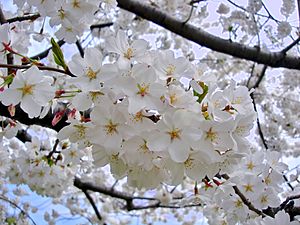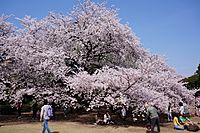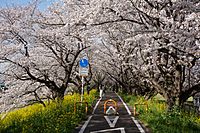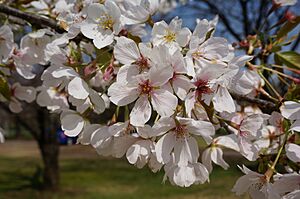Prunus × yedoensis facts for kids
Quick facts for kids Prunus × yedoensis |
|
|---|---|
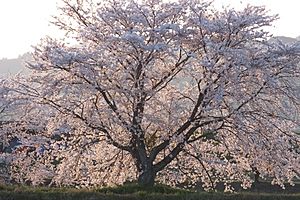 |
|
| Cherry tree in full bloom (Tamba-Sasayama, Hyogo) | |
| Scientific classification | |
| Genus: |
Prunus
|
| Species: |
× yedoensis
|
| Synonyms | |
|
|
The Prunus × yedoensis is a special kind of hybrid cherry tree. It's a mix of two other cherry trees: the Prunus speciosa (called Oshima cherry) and the Prunus pendula f. ascendens (known as Edo higan). This hybrid tree first appeared in Japan.
One of its most famous types is called Prunus × yedoensis 'Somei-yoshino' or Yoshino cherry. In Japanese, this is 染井吉野 ソメイヨシノ Somei Yoshino. It's one of the most popular and widely planted cherry trees around the world today.
The 'Somei-yoshino' is a clone from a single tree. This means all 'Somei-yoshino' trees are genetically identical. They are grown by grafting, which is like taking a branch from one tree and attaching it to another.
This tree gets great qualities from its parent trees. From the Edo higan, it blooms before its leaves appear and grows into a large tree. From the Oshima cherry, it grows quickly and has beautiful white flowers. These features make it a favorite cherry tree.
Wild P. × yedoensis trees grow near Funabara Pass on the Izu Peninsula. This area is close to where its parent, the Oshima cherry, first grew. The wild trees there are called 'Funabara-yoshino'.
In 2019, scientists from several Japanese universities studied the 'Somei-Yoshino'. They decoded all its genetic information. This study confirmed that 'Somei-yoshino' came from Edo higan and Oshima cherry. They also found that these two parent species separated millions of years ago. The 'Somei-yoshino' hybrid itself was created over 100 years ago.
Contents
What's in a Name?
In 1900, a person named Yorinaga Fujino gave the Yoshino cherry its name, Somei-yoshino. He named it after Somei village, a famous place where it was grown. This village is now part of Toshima, Tokyo. He also included the name of Mount Yoshino, a famous place for another type of cherry tree.
The next year, in 1901, Jinzō Matsumura gave it the scientific name Prunus yedoensis. Later, in 1916, a botanist named Ernest Henry Wilson suggested it was a hybrid. Because it's a mix of two species, its scientific name became Prunus × yedoensis. The "×" means it's a hybrid.
There's also a Korean native cherry called King cherry. This tree was given a similar scientific name, Prunus yedoensis var. nudiflora, in 1912. It's still sometimes called Prunus yedoensis. The Yoshino cherry itself doesn't have a special scientific name for its specific type. This is because it's the original type of this hybrid species.
Tree Description and Features
The Prunus × yedoensis is a small, deciduous tree. Deciduous means it loses its leaves every year. It usually grows to be about 5 to 12 meters (16 to 39 feet) tall. Sometimes, it can even reach 15 meters (49 feet).
These trees grow well in places with mild winters, like hardiness zones 5–8. They need lots of sunshine and soil that is moist but drains well.
The leaves are arranged in an alternating pattern along the branch. They are about 6 to 15 cm (2.4 to 5.9 inches) long and 4 to 7 cm (1.6 to 2.8 inches) wide. Their edges are serrated, meaning they look like a saw. When new leaves first appear, they often have a bronze color. By summer, they turn a dark green.
The beautiful flowers appear in early spring, even before the leaves. They smell nice and are about 3 to 3.5 cm (1.2 to 1.4 inches) wide. Each flower has five white or pale pink petals. The flowers grow in clusters of five or six together.
After the flowers, the tree produces small cherries. These are round, fleshy fruits called drupes, about 8 to 10 mm (0.3 to 0.4 inches) across. They are an important food source for many small birds and mammals. Birds like robins and thrushes enjoy them. The fruit has little flesh but a lot of concentrated red juice. This juice can stain clothes and even bricks! For humans, the fruit is only slightly sweet.
Growing and Caring for Yoshino Cherries
With its lovely, light pink flowers, easy-to-manage size, and graceful shape, the Yoshino cherry is often planted as an ornamental tree. This means it's grown for its beauty. Many different types, or cultivars, have been chosen. Some well-known ones include 'Akebono' and 'Ivensii'.
From the Edo period in Japan (1603-1868) to the early Meiji period (1868-1912), gardeners in a village called Somei in Edo (now Tokyo) grew these trees. They first called them Yoshinozakura. But in 1900, Dr. Fujino renamed them someiyoshino.
The Yoshino cherry trees were brought to Europe and North America in 1902. One famous example is the National Cherry Blossom Festival in Washington, D.C.. This festival celebrates the gift of Japanese cherry trees from Tokyo to Washington in 1912. These trees are planted around the Tidal Basin park.
Other cities also received these beautiful trees. In 1959, Tokyo gave 2,000 Japanese cherry trees to Toronto, Canada. Many were planted in High Park. In New York City, Pilgrim Hill in Central Park is famous for its groves of pale Yoshino cherry trees that bloom in spring.
-
Yoshino cherry in Shinjuku Gyo-en.
Parent Trees of the Yoshino Cherry


Most studies show that the Yoshino cherry ('Somei-yoshino') is a hybrid. It's a mix of two specific cherry trees. These are Prunus speciosa (the Oshima cherry) and Prunus pendula f. ascendens (also known as Edo higan).
Scientists have used different methods to confirm this. For example, in 1916, Ernest Henry Wilson first suggested this parentage. Later, in 1995, DNA fingerprinting studies showed that all 'Somei-yoshino' trees in Japan came from one original hybrid plant. This hybrid was created by crossing an Oshima cherry and an Edo higan.
The Oshima cherry is a native tree found only around the Izu Islands, Izu, and Bōsō Peninsulas in Japan. It does not grow naturally around the Korean Peninsula.
Where Did It Come From?
For a while, there was a debate about where the Yoshino cherry tree first came from.
In 1908, a French missionary found a native cherry tree on Jeju Island, Korea. In 1912, a German botanist named Koehne gave it the scientific name Prunus yedoensis var. nudiflora. For some time, people mistakenly thought this meant the Yoshino cherry grew naturally on Jeju Island.
In 1933, a Japanese botanist suggested the Yoshino cherry came from Jeju island in South Korea. This led to claims that Japan had taken the Yoshino cherry from Korea.
However, later scientific studies helped to clear this up. In 1962, a study on the tree's shape ruled out the idea of it being from Korea. In 1995, DNA studies confirmed that the Yoshino cherry grown in Japan is a clone from a single hybrid tree. This tree was created by people in Edo (Tokyo) around 1720–1735.
In 2007, a study compared the Japanese Yoshino cherry with the Korean King cherry. It found that these two trees are actually different species. This confirmed that the claim of the Yoshino cherry being from South Korea was not correct. In 2016, the King cherry was given a new scientific name, Cerasus × nudiflora, to show it is distinct from the Yoshino cherry (Prunus × yedoensis).
Other Types of Yoshino Cherry
The Prunus × yedoensis has many other types, or cultivars, besides the famous 'Somei-yoshino'.
- ‘Amagi-yoshino’ (天城吉野)
- ‘America’ (アメリカ) (or 'Akebono' in the U.S.)
- ‘Candida’ (薄毛大島, Usuge-oshima)
- ‘Funabara-yoshino’ (船原吉野)
- ‘Hayazaki-oshima’ (早咲大島)
- ‘Izu-yoshino’ (伊豆吉野)
- ‘Kichijouji’ (吉祥寺)
- ‘Kurama-zakura’ (鞍馬桜)
- ‘Mikado-yoshino’ (御帝吉野)
- ‘Mishima-zakura’ (三島桜)
- ‘Morioka-pendula’ (盛岡枝垂, Morioka-shidare)
- ‘Naniwa-zakura’ (浪速桜)
- ‘Pendula’ (枝垂大臭桜), Shidare-ookusai-zakura
- ‘Perpendens’ (枝垂染井吉野, Shidare-somei-yoshino)
- ‘Pilosa’ (毛大島桜, Ke-oshima-zakura)
- ‘Sakabai’ (仙台吉野, Sendai-yoshino)
- ‘Sakuyahime’ (咲耶姫)
- ‘Sasabe-zakura’ (笹部桜)
- ‘Shouwa-zakura’ (昭和桜)
- ‘Somei-higan’ (染井彼岸)
- ‘Somei-nioi’ (染井匂)
- ‘Sotorihime’ (衣通姫)
- ‘Suruga-zakura’ (駿河桜)
- ‘Syuzenzi-zakura’ (修善寺桜)
- ‘Waseyoshino’ (早生吉野)
- ‘Somei-beni’ (染井紅)
See also
 In Spanish: Prunus × yedoensis para niños
In Spanish: Prunus × yedoensis para niños


